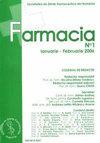INCISION-WOUND HEALING ACTIVITY OF SUNFLOWER SEED OIL (HELIANTHUS ANNUUS L.: IN VIVO AND IN SILICO STUDY
IF 1.4
4区 医学
Q4 PHARMACOLOGY & PHARMACY
引用次数: 0
Abstract
Sunflower seed oil (SFO) ( Helianthus annuus L.) is rich in oleic acid and unsaturated fatty acids and can potentially treat various ailments. To validate the ethno-therapeutic claims of the SFO in skin diseases, the incision wound healing activity was studied. The objectives of this study were to evaluate the chemical content and incision wound-healing activities of SFO. Twenty-seven adult male Wistar rats were used, and a 2 cm length and 2 mm depth incision was made on the back of the rat. The rats were administered SFO, povidone iodine (PI), or were left untreated as a control group. Histological evaluations were conducted on postoperative wound tissue biopsies on days 0, 5 and 10. The SFO compounds were assessed using GC/MS analysis, and a subsequent in silico investigation was conducted based on the GC/MS findings. The binding affinity of these compounds to TNF-α, VEGFR1, IGFR1 and TGF-β1 was evaluated. On day 10, sunflower seed oil topical application accelerated wound healing by decreasing wound area and increasing wound contraction compared to untreated and PI-treated wounds. Moreover, granulation tissue expanded more, and the epidermis fully recovered. Twenty-four active compounds were detected using GC/MS, and six are responsible for lipid metabolism regulation and anti-inflammatory activity. The in silico study showed that 9,10-Secocholesta-5,7,10(19)-triene-3,24,25-triol (3ß,5Z,7E) had a high affinity of - 8.5 kcal/mol for TNF-α. The conclusion of this study shows that SFO has incision wound healing activity in vivo and in silico by controlling the inflammatory phase and proangiogenic factors with a high affinity to bind to TNF-α in the skin tissue向日葵籽油的切口愈合活性:体内和硅学研究
向日葵籽油(Helianthus annuus L.)富含油酸和不饱和脂肪酸,可治疗多种疾病。为了验证葵花籽油对皮肤病的民族治疗功效,我们对其切口伤口愈合活性进行了研究。本研究的目的是评估 SFO 的化学成分和切口伤口愈合活性。研究人员使用 27 只成年雄性 Wistar 大鼠,在大鼠背部切开一个长 2 厘米、深 2 毫米的切口。给大鼠注射 SFO、聚维酮碘(PI)或不作处理作为对照组。对术后第 0、5 和 10 天的伤口组织活检进行组织学评估。通过 GC/MS 分析对 SFO 化合物进行了评估,随后根据 GC/MS 分析结果进行了硅学研究。评估了这些化合物与 TNF-α、VEGFR1、IGFR1 和 TGF-β1 的结合亲和力。第 10 天,与未经处理的伤口和 PI 处理的伤口相比,葵花籽油局部涂抹可通过减少伤口面积和增加伤口收缩加速伤口愈合。此外,肉芽组织扩张更多,表皮完全恢复。利用气相色谱/质谱仪检测到了 24 种活性化合物,其中 6 种具有调节脂质代谢和抗炎活性。硅学研究表明,9,10-Secocholesta-5,7,10(19)-triene-3,24,25-triol (3ß,5Z,7E)与 TNF-α 的亲和力高达 - 8.5 kcal/mol。这项研究的结论表明,SFO 通过控制炎症阶段和促血管生成因子与皮肤组织中的 TNF-α 高亲和力结合,在体内和硅学中具有切口伤口愈合活性。
本文章由计算机程序翻译,如有差异,请以英文原文为准。
求助全文
约1分钟内获得全文
求助全文
来源期刊

FARMACIA
医学-药学
CiteScore
2.40
自引率
50.00%
发文量
59
审稿时长
6-12 weeks
期刊介绍:
FARMACIA publishes original research papers, invited topical reviews and editorial commentaries and news, with emphasis on conceptual novelty and scientific quality. Main research areas are focused on: pharmacology, toxicology, medicinal chemistry, biopharmacy, drug design, drug delivery, personalized medicine, nanostructures, nutraceuticals, biochemistry and biotechnology. Manuscripts submitted to the Journal are only accepted after the peer review precess. The papers should have not been published in any other journal. The recommendations of the Declaration of Helsinki, for humans, and the International guidelines as accepted principles for the use of experimental animals should be followed.
 求助内容:
求助内容: 应助结果提醒方式:
应助结果提醒方式:


